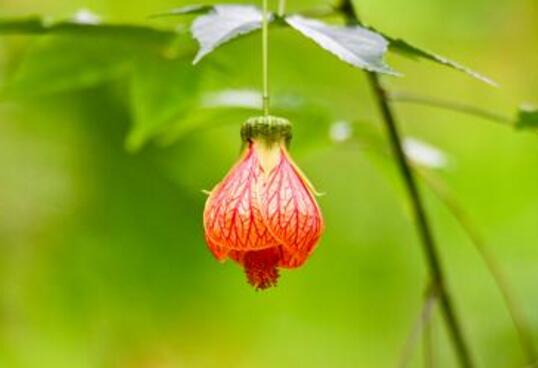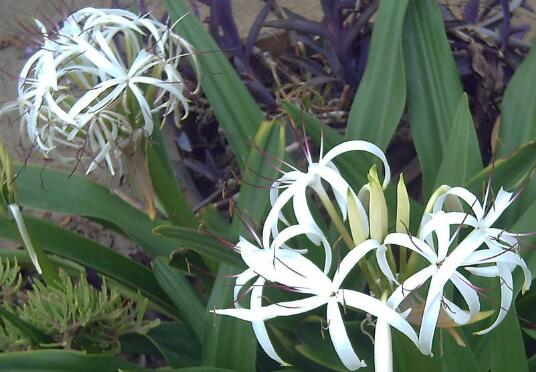Wind chimes wilted how to deal with, learn four tricks to avoid wilting / attached treatment skills
Although the flowering period of Campanula is not the longest, the viewing time of as long as 2 months from April to June can also make many flower friends feast their eyes, but some flower friends will encounter the wilting of the wind chimes, which not only affects the beauty but also shows that there are problems in maintenance and management. and how to deal with the wilting of the wind chimes? The editor will tell you how.
How to deal with the wilting of wind chimes
1. Reduce watering

The wind bell flower needs a lot of water during the growing period, so it is watered more frequently, but some flower friends do not know how to judge whether it should be watered or not, and how much it should be watered. The roots will wilt because they can't breathe.
Treatment method: need to reduce watering times and dosage, the way to judge is to see whether there is water outflow from the flowerpot drainage hole, and whether there is stagnant water in the flowerpot, if there is no water outflow, it has not been watered through, and if there is stagnant water, it means that there is too much watering.
2. Increase the illumination
Campanula prefers sunny places, but it can also tolerate a semi-shady environment, but it can not stay in places without light for a long time, otherwise it may lead to leaf wilting, which is due to its low photosynthesis and poor growth.
Treatment: how to deal with the wilting of wind chimes caused by lack of light? The way to do this is to increase the light and keep it in sunny places when the temperature is no more than 35 degrees, but it needs shade in summer.
3. Change the soil
In most cases, as long as the soil for planting bluebells is relatively fertile and loose, the leaves will rarely wilt because of soil problems, but if we do not pay attention to environmental management and scientific fertilization, the soil conditions will become worse and may be lack of nutrition.
Treatment: change the soil as soon as possible when the temperature is appropriate, usually in April, do not use tap water with too high alkalinity when watering, and pay attention to the application of phosphorus and potassium fertilizer to avoid the lack of iron in the soil.
4. Pest control
The common diseases and insect pests of Campanula are aphids, red spiders, powdery mildew, leaf spot and so on, which will cause yellowing, curling, wilting and so on, and more plants will be damaged if they are not dealt with in time.
Treatment methods: understand the prevention and control methods of diseases and insect pests of Campanula, spray carbendazim, EC, thistle, methyl thiophanate wettable powder, etc., and then strengthen environmental management and scientific maintenance. reduce the possibility of insect sources and pathogens appearing on bluebells, and do a good job in pruning and reproduction of bluebells.
How to prevent the grass from wilting when it wilts?
Reticulate grass is a common indoor foliage plant, but in the process of maintenance, it may wilt due to improper maintenance and seriously affect the ornamental value of reticulated grass. What if the reticulate grass wilts? How to prevent the reticulate grass from wilting? Let's take a look at the answer next.
What if the reticulate grass wilts?
What to do if the reticulate grass wilts: lack of water
The reticulate grass is not watered thoroughly, which leads to the lack of water and wilting of the reticulated grass. The best solution is to replenish the water immediately. Generally speaking, it can recover after half a day. The correct watering method should be to look at the topsoil, dry and wet, water thoroughly, the number of times should not be fixed, look at the soil to see the sky change at any time. Topsoil is a shallow soil layer of 3cm to 5cm. Dry and wet conditions are tested with toothpicks or tweezers and poured through.
What to do if the reticulate grass wilts? overwatering.
Frequently watering the reticulate grass will cause stagnant water in the soil and poor root breathing, which will lead to the wilting of the rotten root. Try to pull out the reticulate grass and replant it, but the possibility of recovery is not great.
What to do if the reticulate grass wilts? third, the temperature is too low.
When the temperature is lower than 13 ℃, the leaves will be withered and wilted, so when the temperature can not be guaranteed in winter, it is recommended not to raise reticulate grass easily.
How to prevent the wilting of reticulated grass
Reticulate grass should be in a humid environment, and the growing period needs higher air humidity, especially in the summer high temperature season, the water evaporation is large and the air is dry. In addition to watering to increase the humidity of the basin soil, foliar spraying and ground sprinkling are more necessary. Keeping high air humidity is beneficial to the growth of stems and leaves of Rabdosia paniculata. But the drainage of the basin soil should be good, the water cannot be accumulated, and the leaves can not be soaked in the water fog for a long time, otherwise the color and luster of the leaves will turn white, which can easily cause shedding and decay. In winter or rainy days, the basin soil can be slightly drier and the air humidity can be moderate.
Scattered light is the best in reticulate grass, and direct light is avoided. Sunshade net should be set up in summer, and the shading rate of 50% to 60% is the most suitable. Sufficient sunshine is needed in winter, shade and protection at noon, auxiliary light should be increased in rainy and snowy days, leaves grow healthily, leaves are green and veins are clear. If it is too shaded for a long time, the stems and leaves are easy to grow, and the ornamental value of leaves is poor.
What if the lantern flower leaves wilt, add light / appropriate amount of fertilization / do cooling treatment
As a common flower, the breeding method of lantern flower is not difficult, as long as the right amount of water and fertilizer, astigmatism maintenance, it will produce beautiful flowers. But in the process of breeding, there are still many flower friends maintenance problems, resulting in lantern flower leaves wilting, affecting the ornamental of the plant. What if the lantern flowers wilt their leaves? Today, the editor will solve this problem for you.
First, the lantern flower leaves wilted, look for the cause
The beauty of the lantern flower, 9 points in the flower, 1 point in the leaf, nevertheless, leaf problems, will also affect the lantern flower blossom. In life, the lantern flowers of many flower friends wilt when they raise leaves. How is this going on? In this regard, the editor summed up four reasons: too little light, insufficient fertilization, too high temperature, and the growth environment is too poor, the specific solution, let's move on.
Second, the causes and solutions of the wilting leaves of lantern flowers.
1. Lack of light
Although the lantern flower can grow in a semi-overcast environment, it can not be long, because its growth needs more light. Once the light is insufficient, the photosynthesis of the lantern flower leaves will be blocked, resulting in a lack of nutrition and wilting of the leaves.
Solution: lack of light, naturally need to fill light, found that the lantern flower leaves wilted, flower friends should put the lantern flower in a place with good light, such as balcony, windowsill and other places. If the conditions are limited, you can use fluorescent lamps to fill the light.
2. Lack of nutrients
The growth of lantern flowers needs sufficient nutrients, and the source of nutrients, in addition to photosynthesis, is fertilization. Once the fertilization is too little, resulting in a lack of nutrients, the lantern flower leaves will also wilt.
Solution: timely supplement of fertilizer and water, but fertilizer can not be applied more nor less, flower friends can refer to the lantern flower fertilization method. As long as the proper amount of fertilizer is applied, the leaves of lantern flowers will return to health.
3. The temperature is too high
Lantern flowers like a cool environment, and their leaves wilt easily in hot and hot summer. The reason for this is that the lantern flower is a kind of plant that is afraid of high temperature. if the air humidity is not enough or the temperature is too high, its leaves will wilt.
Solution: cool the lantern flowers, move the plants to a cool and ventilated place, such as a north-facing windowsill in your home, and spray a small amount of water on the leaves and soil. After careful care for a period of time, the lantern leaves will return to health.
4. The environment is too bad
Although the lantern flower is adaptable, its growth environment is too poor, such as being attacked by strong winds or being washed away by Rain Water in the rainy season, it will have various problems, such as wilting leaves or being attacked by diseases and insects.
Solution: move the lantern flowers to a ventilated room with astigmatism to avoid wind and rain. If you are attacked by diseases and insect pests, spray in time for prevention and control, specific what medicine should be sprayed, you can refer to the disease and insect pest control of lantern flowers.
- Prev

What if the peacock bamboo taro is not tall? it is the key to achieve 5 points to grow ferociously / to control fertilization.
Peacock taro is a beautiful foliage plant with broad leaves and a pattern of peacock feathers, which looks particularly charming. But if the plant is not tall, the beauty of bare leaves is not good, because the whole will be very awkward, then how to do if the peacock taro is not tall? In this regard, the editor summed up five points, as long as we do it.
- Next

Can Manjusri be hydroponically cultivated? the method of hydroponics / changing water frequently / avoiding strong light
Wenshulan is a kind of highly ornamental flower plant, which can be seen in many parts of our country. It is usually planted in the way of soil culture, but some people want to try hydroponics, so can Manjusri be hydroponic? Actually, it can. So what is the method of Shui Pei Wen Shu Lan?
Related
- Fuxing push coffee new agricultural production and marketing class: lack of small-scale processing plants
- Jujube rice field leisure farm deep ploughing Yilan for five years to create a space for organic food and play
- Nongyu Farm-A trial of organic papaya for brave women with advanced technology
- Four points for attention in the prevention and control of diseases and insect pests of edible fungi
- How to add nutrient solution to Edible Fungi
- Is there any good way to control edible fungus mites?
- Open Inoculation Technology of Edible Fungi
- Is there any clever way to use fertilizer for edible fungus in winter?
- What agents are used to kill the pathogens of edible fungi in the mushroom shed?
- Rapid drying of Edible Fungi

